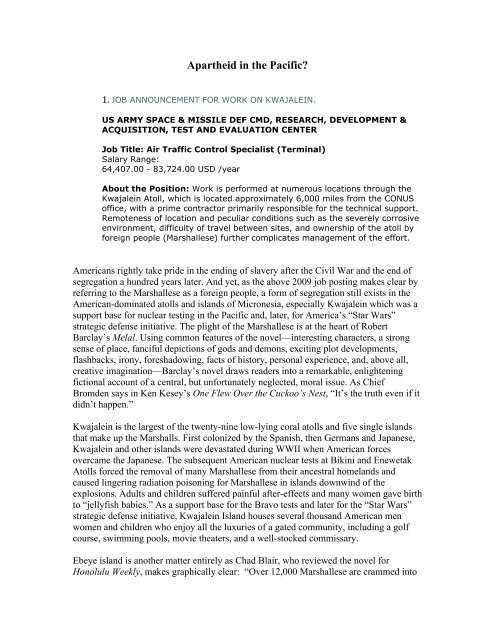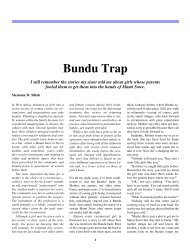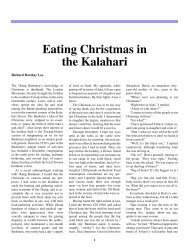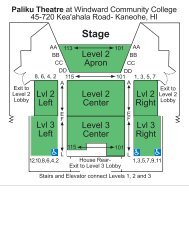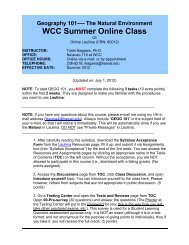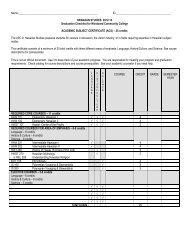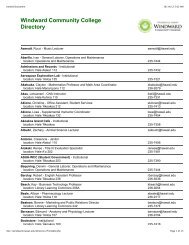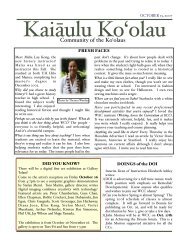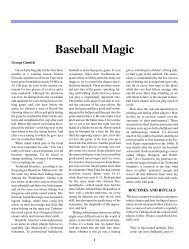class guide for Melal (PDF) - Windward Community College
class guide for Melal (PDF) - Windward Community College
class guide for Melal (PDF) - Windward Community College
Create successful ePaper yourself
Turn your PDF publications into a flip-book with our unique Google optimized e-Paper software.
Apartheid in the Pacific?<br />
1. JOB ANNOUNCEMENT FOR WORK ON KWAJALEIN.<br />
US ARMY SPACE & MISSILE DEF CMD, RESEARCH, DEVELOPMENT &<br />
ACQUISITION, TEST AND EVALUATION CENTER<br />
Job Title: Air Traffic Control Specialist (Terminal)<br />
Salary Range:<br />
64,407.00 - 83,724.00 USD /year<br />
About the Position: Work is per<strong>for</strong>med at numerous locations through the<br />
Kwajalein Atoll, which is located approximately 6,000 miles from the CONUS<br />
office, with a prime contractor primarily responsible <strong>for</strong> the technical support.<br />
Remoteness of location and peculiar conditions such as the severely corrosive<br />
environment, difficulty of travel between sites, and ownership of the atoll by<br />
<strong>for</strong>eign people (Marshallese) further complicates management of the ef<strong>for</strong>t.<br />
Americans rightly take pride in the ending of slavery after the Civil War and the end of<br />
segregation a hundred years later. And yet, as the above 2009 job posting makes clear by<br />
referring to the Marshallese as a <strong>for</strong>eign people, a <strong>for</strong>m of segregation still exists in the<br />
American-dominated atolls and islands of Micronesia, especially Kwajalein which was a<br />
support base <strong>for</strong> nuclear testing in the Pacific and, later, <strong>for</strong> America’s “Star Wars”<br />
strategic defense initiative. The plight of the Marshallese is at the heart of Robert<br />
Barclay’s <strong>Melal</strong>. Using common features of the novel—interesting characters, a strong<br />
sense of place, fanciful depictions of gods and demons, exciting plot developments,<br />
flashbacks, irony, <strong>for</strong>eshadowing, facts of history, personal experience, and, above all,<br />
creative imagination—Barclay’s novel draws readers into a remarkable, enlightening<br />
fictional account of a central, but un<strong>for</strong>tunately neglected, moral issue. As Chief<br />
Bromden says in Ken Kesey’s One Flew Over the Cuckoo’s Nest, “It’s the truth even if it<br />
didn’t happen.”<br />
Kwajalein is the largest of the twenty-nine low-lying coral atolls and five single islands<br />
that make up the Marshalls. First colonized by the Spanish, then Germans and Japanese,<br />
Kwajalein and other islands were devastated during WWII when American <strong>for</strong>ces<br />
overcame the Japanese. The subsequent American nuclear tests at Bikini and Enewetak<br />
Atolls <strong>for</strong>ced the removal of many Marshallese from their ancestral homelands and<br />
caused lingering radiation poisoning <strong>for</strong> Marshallese in islands downwind of the<br />
explosions. Adults and children suffered painful after-effects and many women gave birth<br />
to “jellyfish babies.” As a support base <strong>for</strong> the Bravo tests and later <strong>for</strong> the “Star Wars”<br />
strategic defense initiative, Kwajalein Island houses several thousand American men<br />
women and children who enjoy all the luxuries of a gated community, including a golf<br />
course, swimming pools, movie theaters, and a well-stocked commissary.<br />
Ebeye island is another matter entirely as Chad Blair, who reviewed the novel <strong>for</strong><br />
Honolulu Weekly, makes graphically clear: “Over 12,000 Marshallese are crammed into
an island slum roughly the size of Ala Moana center.” They suffer frequent electrical<br />
outages and insufficient sewage removal. The vast lagoon is polluted near shore and is<br />
off limits further out because of unarmed missiles fired from Cali<strong>for</strong>nia. Jobs are few,<br />
supplies expensive, and health care poor. Pacific Islands Development expert Robert<br />
Kiste calls Ebeye “the American version of Apartheid in the Pacific.” Readers of <strong>Melal</strong><br />
are quickly exposed to this reality. On Good Friday 1981 Rujen Keju starts his day trying<br />
to kill a rat in the falling apart, “army-built, concrete blockhouse” he shares with<br />
“fourteen clan members and eight family members” (3). Fortunate to have a job on<br />
Kwajalein, he must take a ferry three miles to work every day to a place where<br />
Marshallese are only allowed by permit and are <strong>for</strong>bidden to enter most of the<br />
establishments, including the commissary where inexpensive goods are available only to<br />
Americans. Rujen, though, is one of the lucky ones; most of the Marshallese are either<br />
relatives of wage earners or evacuees from other islands.<br />
This is a harsh background <strong>for</strong> a novel that is sometimes humorous and whimsical as well<br />
as somber. Yet at its heart remains the question, What does it take to break down race<br />
barriers? One clear way not to do it is provided by the story of Rujen’s nephew, Lazarus,<br />
who has been having a clandestine affair with an American woman he hopes to marry in<br />
order to become a citizen. But once the affair becomes known, the girlfriend is too<br />
ashamed to acknowledge her active role: “Melody didn’t even say good-bye, didn’t even<br />
look at me, when they dragged me out of there [her apartment] and took me to jail” (278).<br />
The novel does, though, suggest some ways that progress can be made. Most obvious is<br />
the dramatic change Rujen undergoes during the course of the day, with one mishap<br />
following another. Despite having lost his wife to radiation poisoning nine years earlier,<br />
Rujen has decided that protesting against the American presence, as his father had, is<br />
useless. Instead he has come to accept the American presence and is now proud of being<br />
the highest level Marshallese worker at the sewage treatment plant and feels that being an<br />
usher at the Catholic church on Kwajalein is what defines him. And yet, after having his<br />
rubber boots stolen and his bike vandalized, Rujen begins to lose his optimism about<br />
Ebeye’s future. This unraveling is furthered when Rujen, while having lunch at the turtle<br />
pond, finds himself unexpectedly taking the Marshallese position about the dolphins and<br />
antagonizing Rick and the other Americans. His epiphany occurs when Rujen<br />
accidentally crashes the crucifix during the Good Friday mass. Already covered with<br />
chum and smelling like shit, having dirtied both the money collected to save the dolphins<br />
and the holy water, he now begins to understand Catholicism from a Marshallese<br />
perspective. Previously he had simply memorized the liturgy without understanding it;<br />
now he comes to view Christ as “a man, a once living breathing man whose ancient land<br />
had <strong>for</strong> so long been occupied and dominated…. For Rujen to understand Jesus Christ<br />
this way was to come to an understanding of himself, not just as a man but as a<br />
Marshallese and as the son of his father” (273). This new sense of himself brings Rujen<br />
closer not only to his father but to his son.<br />
Jebro, from the beginning, has been more like his grandfather than his father. Named<br />
after “the king of the stars, the greatest hero ever in the Marshall Islands,” Jebro is proud<br />
of his “long extra pinkie . . . which he boasted could bring fish by wiggling in the water”
(4). Just back from two years on an outer island, he is determined to take his younger<br />
brother across the lagoon to Tar-Woj, his birthplace and the resting place of Rujen’s<br />
father—despite its being within the missile range. But unlike his older brother, Nuke has<br />
no interest in or knowledge of Marshallese culture. Named after “the most powerful thing<br />
on earth” (4), his world is shaped by cigarettes, gangs, suicides. To him and many<br />
Marshallese Ebeye was “New York, Tokyo, Hong Kong, Manila, the closest a<br />
Marshallese might ever get to experiencing the life such places offered” (79). The sharp<br />
contrast between these two brothers mirrors Rujen’s internal conflict and the broader<br />
cultural conflict.<br />
The struggle between good and evil in the realm of the gods rein<strong>for</strong>ces the message that<br />
the Marshallese must begin to regain a sense of cultural identity. The trickster Etao<br />
provides a sense of lightheartedness that, it is implied, is an important part of life and can,<br />
unexpectedly, drive off the <strong>for</strong>ces of evil. And the dwarf Noniep, the last of his race, is<br />
determined to save the souls of all the dead jellyfish babies and other Marshallese. Yet<br />
after Etao has saved him from the demons, Noniep comes to realize that the island of the<br />
dead is not the right place <strong>for</strong> him to take the souls. Instead, the role of the dead should be<br />
to go back where they came from and be spirit guardians, like the frigate bird that saves<br />
Nuke from drowning.<br />
Barclay is well aware that it will take more than renewed pride in Marshallese heritage<br />
<strong>for</strong> the racial and cultural divide to be healed. The Americans, too, must come to a new<br />
understanding of the Marshallese. This is provided by the interaction of Jebro and Nuke<br />
with the American boys—Travis, Boyd and Kerry. While Boyd is an insensitive and selfcentered<br />
teenager, Travis is intrigued by Jebro’s ability to anticipate the movements of<br />
schools of fish. Kerry, a newcomer to Kwajalein, rejects Boyd’s view of the Marshallese<br />
and begins to open up to cross-cultural awareness. All three boys are shocked by the<br />
condition of Ebeye when they drop off Jebro and Nuke—none of them had previously<br />
been aware of how shitty Ebeye really was. Yet Travis is impressed with how happy the<br />
little kids are playing at the edge of the lagoon. It seems clear that he and Jebro have<br />
<strong>for</strong>med a bond that will lead to a better understanding of each other. This is a small but<br />
significant beginning.<br />
<strong>Melal</strong> is a significant contribution to literature of the Pacific. It won the Harriet<br />
Goldsberry Award in Hawai`i and was a finalist <strong>for</strong> the prestigious Kiriyama Prize <strong>for</strong><br />
fiction. Barnes and Noble selected <strong>Melal</strong> <strong>for</strong> its Discover Great New Writers program.<br />
Maori writer Patricia Grace’s enthusiastic endorsement of the novel highlights its<br />
significance. Although Barclay is not a Pacific Islander, he knows the situation in<br />
Kwajalein first hand. When he was nine, his father took a job at the U.S. missile range<br />
and moved his family there. Since graduating from Kwajalein Junior/Senior High school,<br />
Barclay has returned to Kwajalein many times <strong>for</strong> visits and a couple of year-long stints<br />
of employment. One can’t help but suspect that Travis in the novel comes close to<br />
representing Barclay’s own journey to understanding.
Annotated Bibliography<br />
Barclay, Robert. <strong>Melal</strong> (University of Hawai`i Press, 2002). This paperback edition is the<br />
only one so far. All page references are necessarily to this edition.<br />
Barclay, Robert. His website at http://windward.hawaii.edu/people/robert_barclay/<br />
contains links to a number of reviews of <strong>Melal</strong>.<br />
Blair, Chad. “A particularly bad Friday: First-time novelist Robert Barclay spins a<br />
horrific and hopeful Marshallese tale.” (Honolulu Weekly, November 2002). This review<br />
is particularly interesting because Blair, like Barclay, graduated from Kwajalein<br />
Junior/Senior High School.<br />
Kesey, Ken. One Flew Over the Cuckoo’s Nest (Viking Press, 1962). Chief Bromden is<br />
the first person narrator and a central character of the novel, set in an insane asylum. For<br />
most of the novel Bromden appears to others to be deaf and dumb. This caused the critic<br />
Leslie Fiedler to refer to him as “the invisible American.” Many comparisons, of course,<br />
can be made between the treatment of “redskins” and the Marshallese. Most people know<br />
One Flew Over the Cuckoo’s Nest from the 1975 movie starring Jack Nicholson rather<br />
than from the novel. However, the movie minimizes the importance of Chief Bromden<br />
and Kesey refused to have his name on the credits.<br />
Kiste, Robert. Review of <strong>Melal</strong>: A Novel of the Pacific (The Contemporary Pacific,<br />
Spring 2004). As a fellow in the East-West Center’s Pacific Islands Development<br />
Program, Kiste is able to provide useful in<strong>for</strong>mation about the setting of the novel.<br />
Shel Hershinow<br />
Professor Emeritus, Literature<br />
Kapi`olani <strong>Community</strong> <strong>College</strong>


